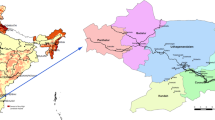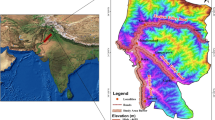Abstract
India ranks first in the world in terms of fatal landslides. Large vulnerable area (0.42 million km2), high population density and monsoon rainfall make India’s landslide management and mitigation task difficult. Therefore, an understanding of landslide occurrences and exposure of socio-economic parameters on a national scale is essential to prioritise landslide mitigation efforts. In this paper, a database of 45,334 landslides (polygons) in India mapped by the National Remote Sensing Centre (NRSC) during the 1998–2018 period was compiled and catalogued in a WebGIS platform. High-resolution satellite data such as IRS PAN+LISS-III, Resourcesat LISS-IV Mx, Cartosat, WorldView, Pleiades and GeoEye were used to map landslides as small as 12 m2 to as big as 1,390,350 m2. GIS analysis using the landslide inventory revealed interesting results about control, exposure and pattern of landslide occurrences in India. The Northwest Himalayas contribute 66.5% of landslides in India, followed by the Northeast Himalayas (18.8%) and the Western Ghats (14.7%). The Greater Himalayan sequence consisting of high-grade metamorphic rocks has a considerable control (32%), and the Main Central Thrust is the major regional structure controlling (12%) landslides in India. In the Northeast Himalayas, the size of landslides and the slope gradient controlling landslide occurrence are less in comparison to the Northwest Himalayas and the Western Ghats. Landslides in the Western Ghats are triggered with a lesser amount of rainfall than the Himalayan regions. Exposure analysis using four key socio-economic parameters in the 145 hilly districts shows that Rudraprayag district is most affected by landslides in India. The understanding derived using the landslide database on a national scale will help to prioritise and strengthen landslide disaster risk reduction strategies in India.










Similar content being viewed by others
References
Anbalagan R (1992) Landslide hazard evaluation and zonation mapping in mountainous terrain. Eng Geol 32:269–277
Brardinoni F, Slaymaker O, Hassan MA (2003) Landslide inventory in a rugged forested watershed: a comparison between air-photo and field survey data. Geomorphology 54:179–196
Census (2011) Census of India 2011. www.censusindia.gov.in/2011
Census (2012) Livestock census of India 2012. www.dadf.gov.in
Cruden DM, Varnes DJ (1996) Landslide types and processes. In: Turner AK, Schuster RL (eds) Landslides-investigation and mitigation. Special Report 247, Transportation Research Board. National Research Council. National Academy Press, Washington DC, pp 36–75
Devoli G, Morales A, Hoeg K (2007) Historical landslides in Nicaragua—collection and analysis of data. Landslides 4:5–18
EM-DAT (2019) EM-DAT International Disaster Database - www.em-dat.net. Université Catholique de Louvain, Brussels, Belgium
Frank W, Grasemann B, Guntli P, Miller C (1995) Geological map of the Kishtwar-Chamba-Kulu region (NW Himalayas, India). Jahrb Geol Bundesanst 138(2):299–308
Froude MJ, Petley DN (2018) Global fatal landslide occurrence from 2004 to 2016. Nat Hazards Earth Syst Sci 18:2161–2181
Gaetani M, Garzanti E (1991) Multicyclic history of the Northern India continental margin (Northwestern Himalaya)(1). AAPG Bull 75(9):1427–1446
Galli M, Ardizzone F, Cardinali M, Guzzetti F, Reichenbach P (2008) Comparing landslide inventory maps. Geomorphology 94:268–289
Gansser A (1964) Geology of the Himalayas. Wiley InterScience, New York, p 289
Gariano SL, Guzzetti F (2016) Landslides in a changing climate. Earth Sci Rev 162:227–252
Ghosh S, Ghosal TB, Mukherjee J, Bhowmik S (2016) Landslide compendium of Darjeeling-Sikkim Himalayas. GSI Special Publication 103, p 195
Ghosh T, Bhowmik S, Jaiswal P, Ghosh S, Kumar D (2020) Generating substantially complete landslide inventory using multiple data sources: a case study in Northwest Himalays, India. J Geol Soc India 95(1):45–58
Guhathakurta P, Rajeevan M (2006) Trends in the rainfall pattern over India. National Climate Centre, Research Report No: 2/2006. National Climate Centre, India Meteorological Department
Guzzetti F (2000) Landslide fatalities and the evaluation of landslide risk in Italy. Eng Geol 58:89–107. https://doi.org/10.1016/S0013-7952(00)00047-8
Hererra G et al (2017) Landslide databases in the geological surveys of Europe. Landslides 15:359–379. https://doi.org/10.1007/s10346-017-0902-z
Herren E (1987) Zanskar shear zone: Northeast-southwest extension within the Higher Himalayas (Ladakh, India). Geology 15(5):409–413
Jaiswal P, van Westen CJ, Jetten V (2011) Quantitative assessment of landslide hazard along transportation lines using historical records. Landslides 8(3):279–291
Jamir I, Gupta V, Thong GT, Kumar V (2019) Litho-tectonic and precipitation implications on landslides, Yamuna valley, NW Himalaya. Phys Geogr 41:1–24. https://doi.org/10.1080/02723646.2019.1672024
Jenness J (2006) Topographic Position Index (tpi_jen.avx) extension for ArcView 3.x, v. 1.2. Jenness Enterprises. Available at: http://www.jennessent.com/arcview/tpi.html.
Kirschbaum DB, Adler R, Hong Y, Hill S, Lerner-Lam A (2010) A global landslide catalog for hazard applications: method, results, and limitations. Nat Hazards 52:561–575
Kirschbaum D, Stanley T, Zhou Y (2015) Spatial and temporal analysis of a global landslide catalog. Geomorphology 249:4–15. https://doi.org/10.1016/j.geomorph.2015.03.016
Lin Q, Wang Y (2018) Spatial and temporal analysis of a fatal landslide inventory in China from 1950 to 2016. Landslides 15:2357–2372
Lin SC, Ke MC, Lo CM (2017) Evolution of landslide hotspots in Taiwan. Landslides 14:1491–1501
Malamud BD, Turcotte DL, Guzzetti F, Reichenbach P (2004) Landslide inventories and their statistical properties. Earth Surf Process Landf 29:687–711
Martha TR, Vinod Kumar K (2013) September, 2012 landslide events in Okhimath, India—an assessment of landslide consequences using very high resolution satellite data. Landslides 10:469–479
Martha TR, Kerle N, Jetten V, van Westen CJ, Vinod Kumar K (2010) Characterising spectral, spatial and morphometric properties of landslides for automatic detection using object-oriented methods. Geomorphology 116:24–36
Martha TR, Kerle N, van Westen CJ, Jetten V, Vinod Kumar K (2011) Segment optimisation and data-driven thresholding for knowledge-based landslide detection by object-based image analysis. IEEE Trans Geosci Remote Sens 49:4928–4943. https://doi.org/10.1109/TGRS.2011.2151866
Martha TR, Kerle N, van Westen CJ, Jetten V, Vinod Kumar K (2012) Object-oriented analysis of multi-temporal panchromatic images for creation of historical landslide inventories. ISPRS J Photogramm Remote Sens 67:105–119
Martha TR, Roy P, Govindharaj KB, Vinod Kumar K, Diwakar PG, Dadhwal VK (2015) Landslide triggered by the June 2013 extreme rainfall event in parts of Uttarakhand state, India. Landslides 12(1):135–146
Martha TR, Kamala P, Josna J, Vinod Kumar K, Jai Sankar G (2016) Identification of new landslides from high resolution satellite data covering a large area using object-based change detection methods. J Indian Soc Remote Sens 44:515–524
Martha TR, Reddy S, Bhatt CM, Babu Govindharaj K, Nalini J, Anantha Padmanabha E, Narender B, Vinod Kumar K, Muralikrishnan S, Rao GS, Diwakar PG, Dadhwal VK (2017) Debris volume estimation and monitoring of Phuktal river landslide-dammed lake in the Zanskar Himalayas, India using Cartosat-2 images. Landslides 14:373–383
Martha TR, Roy P, Khanna K, Mrinalni K, Vinod Kumar K (2019) Landslides mapped using satellite data in the Western Ghats of India after excess rainfall during August 2018. Curr Sci 117(5):804–812
Mathew J, Jha VK, Rawat GS (2009) Landslide susceptibility zonation mapping and its validation in part of Garhwal Lesser Himalaya, India, using binary logistic regression analysis and receiver operating characteristic curve method. Landslides 6:17–26
Mirus et al (2020) Landslides across the USA: occurrence, susceptibility and data limitations. Landslides 17:1–15. https://doi.org/10.1007/s10346-020-01424-4
Nagarajan R, Mukherjee A, Roy A, Khire MV (1998) Temporal remote sensing data and gis application in landslide hazard zonation of part of Western Ghat, India. Int J Remote Sens 19:573–585
NRSA (2001) Atlas on landslide hazard zonation mapping in the Himalayas of Uttarakhand and Himachal Pradesh states using remote sensing and GIS. National Remote Sensing Agency, Hyderabad
NRSC (2014) Land use/land cover database on 1:50,000 scale, Natural Resources Census Project, LUCMD, LRUMG, RSAA. National Remote Sensing Centre, ISRO, Hyderabad
Parkash S, Kathait A (2014) A selected annotated bibliography and bibliography on landslides in India. National Institute of Disaster Management, Ministry of Home Affairs, Government of India, New Delhi-110002, p 172
Paul SK, Bartarya SK, Rautela P, Mahajan AK (2000) Catastrophic mass movement of 1998 monsoons at Malpa in Kali valley. Kumaun Himalaya (India). Geomorphology 35(3-4):169–180
Pennington C, Freeborough K, Dashwood C, Dijkstra T, Lawrie K (2015) The National Landslide Database of Great Britain: acquisition, communication and the role of social media. Geomorphology 249:44–51. https://doi.org/10.1016/j.geomorph.2015.03.013
Ramasamy (2006) Remote sensing and active tectonics of South India. Int J Remote Sens 27(20):4397–4431
Rautela P, Lakhera RC (2000) Landslide risk analysis between Giri and tons rivers in Himachal Himalaya (India). Int J Appl Earth Obs Geoinf 2:153–160
Rosser B, Dellow S, Haubrock S, Glassey P (2017) New Zealand's national landslide database. Landslides 14:1949–1959
Roy P, Martha TR, Vinod Kumar K (2014) Assessment of the Sunkoshi (Nepal) landslide using multitemporal satellite images. Curr Sci 107:1961–1964
Sajinkumar KS, Oommen T (2020) Landslide Atlas of Kerala. Geological Society of India, Bengaluru, p 34
Sajinkumar KS, Anbazhagan S, Pradeepkumar AP, Rani VR (2011) Weathering and landslide occurrences in parts of Western Ghats, Kerala, India. J Geol Soc India 78:249–257
Sarkar S, Kanungo DP (2017) GIS applications in landslide susceptibility mapping of Indian Himalayas. In: Yamagishi H, Bhandary NP (eds) GIS Landslide. Springer, Tokyo, pp 211–219
Sepúlveda SA, Petley DN (2015) Regional trends and controlling factors of fatal landslides in Latin America and the Caribbean. Nat Hazards Earth Syst Sci 15:1821–1833. https://doi.org/10.5194/nhess-15-1821-2015
Shroder JF, Bishop MP (1998) Mass movement in the Himalaya: new insights and research directions. Geomorphology 26:13–35
Singh B (2014) Landslide disaster management. In: Sundaresan J et al (eds) Geospatial technologies and climate change. Springer, Switzerland
Soman K (2002) Geology of Kerala. Geological Society of India, Bangalore, p 335
Steck A (2003) Geology of the NW Indian Himalaya. Eclogae Geol Helv 96:147–196
Taylor FE, Malamud BD, Freeborough K, Demeritt D (2015) Enriching Great Britain's national landslide database by searching newspaper archives. Geomorphology 249:52–68. https://doi.org/10.1016/j.geomorph.2015.05.019
Thampi PK, Mathai J, Sankar G (1995) Landslides (Urul Pottal) in Western Ghats: some field observations. Proc: Seventh Kerala Science Congress, January 1995, Palakkad, 97-99
Valdiya KS (2016) The making of India: geodynamic evolution. Society of Earth Scientists Series. Springer, Cham, p 924
van Westen CJ, Lulie Getahun F (2003) Analyzing the evolution of the Tessina landslide using aerial photographs and digital elevation models. Geomorphology 54:77–89
van Westen CJ, Castellanos E, Kuriakose SL (2008) Spatial data for landslide susceptibility, hazard, and vulnerability assessment: an overview. Eng Geol 102:112–131
Vinod Kumar K, Lakhera RC, Martha TR, Chatterjee RS, Bhattacharya A (2008) Analysis of the 2003 Varunawat landslide, Uttarkashi, India using earth observation data. Environ Geol 55:789–799
Wiesmayr G, Grasemann B (2002) Himalayan fold and thrust belt: Implications for the geodynamic evolution of the NW-Himalaya (India). Tectonics 21(6):8-1-8-19
Acknowledgements
This paper is the outcome of the work carried out under the disaster management support (DMS) program of ISRO. We thank various partner institutes of ISRO for their contribution to the DMS program. We thank Shri Santanu Chowdhury, Director, NRSC, for his support to this work. T.R.M. was the Project Manager of ICSMD for the emergency response to landslide disaster events in India and would like to thank ICSMD and its affiliated organisations for sharing satellite images promptly for the generation of value-added products. We thank Dr. N Aparna, Group Head, NDC, NRSC and her team for providing the IRS satellite data. We also thank Shri M Arulraj and Bhuvan team for their support in the web-based cataloguing of landslides. We thank our colleagues in Geosciences Group, NRSC and few knowledge partner institutions in India who have contributed to this work. Finally, we would like to thank Dr. Shantanu Bhatawdekar, Director, EDPO; Dr. G Srinivasa Rao, Associate Director, EDPO; and Dr. K H V Durga Rao, Group Head, DMSG, NRSC, for their active support to this study.
Author information
Authors and Affiliations
Corresponding author
Supplementary Information
ESM 1
(PDF 339 kb).
Rights and permissions
About this article
Cite this article
Martha, T.R., Roy, P., Jain, N. et al. Geospatial landslide inventory of India—an insight into occurrence and exposure on a national scale. Landslides 18, 2125–2141 (2021). https://doi.org/10.1007/s10346-021-01645-1
Received:
Accepted:
Published:
Issue Date:
DOI: https://doi.org/10.1007/s10346-021-01645-1




